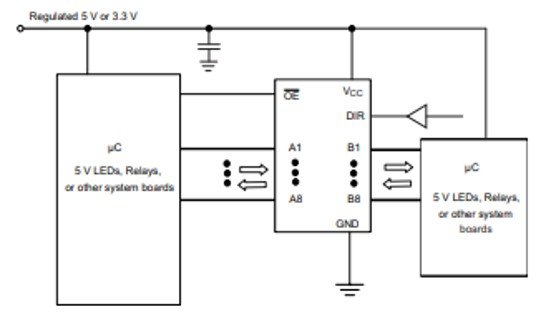74HC245 is an octal transceiver IC used for asynchronous transfer of data between two devices. Furthermore, it supports data transfer at different voltage levels. The internal structure of a chip is composed of two amplifiers. Hence, it can perform two-way communication. This bidirectional communication is achieved by a signal applied at the direction control pin. It has very low input current and consumes less power. These features make it suitable for a large number of applications.
74HC245 Pinout Diagram
This diagram shows the pin assignment octal transceiver IC. Pins A0 to A7 are one side data input/output pins and B0-B7 are the second side input/output pins.
This connection diagram shows the data transfer between two devices. Logic Diagram shows how to connect two devices to transfer data and their connections.
Pin Configuration Description
It is a 20-pin integrated chip that contains two amplifiers namely A and B. The detail of all pins is mentioned below.
Pin#01 DIRECTION CONTROL PIN
The direction control pin (DIR) is used to decide the direction of communication whether data will from amplifier A to B or from B to A.
Pin#02 to 09 A0-A7
These are the pins of amplifier A which can behave as an input as well as output depending on the direction control input.
Pin#10 Ground
Connect this pin with the ground of the circuit.
Pin#11 to 18 B0-B7
These eight pins are of amplifier B which can behave as an input as well as output depending on the direction control input.
Pin#19
It is the active-low output enable pin. It controls the output by enabling or disabling the inputs. This pin is used for cascading.
74HC245 Features
Some main features of this IC include:
- It is a non-inverting transceiver having 3-state outputs for connection with busses.
- This octal IC can perform bidirectional communication.
- The power supply range is 2V to 6V.
- It has a low input current of 1A.
- The propagation delay is 13 ns.
- It has high noise immunity which is a characteristic of CMOS devices.
- The quiescent current is 80 µA.
- The output current is 35mA.
- The output has the capability to drive 15 LSTTL Loads.
- Inputs include clamp diodes to protect them against static discharges.
Where to use 74HC245 3−state noninverting transceiver?
74HC245 IC is widely used in wireless communications and networking applications. Each output of this IC can be either 0 or 1 that is why it is designed for digital use only. It can be used on a CPU board for buffering data on a bidirectional bus or for driving nominal loads. You can use this IC for bidirectional communication in applications requiring low input current, low power consumption and the features mentioned above.
Sometimes, the two hardware’s across which the communication takes place to have different operating voltages. In these cases, we use a potential divider or any other logic level converter. For example, development boards such as MSP432, MSP420, BeagleBoard, and Raspberry Pi operating at 3 volts logic and many analog sensors, digital sensors, LCD displays, TFT displays operates at 5 volts logic, we can use this IC to interface these development boards with this IC. This method is not inefficient for bi-directional communication. Therefore, in such applications, we can use IC 74HC245.
How to use 74HC245?
The 74HC245 is responsible for communication from bus A to bus B or bus B to bus A depending upon the direction control input. When this input is low, data at inputs of amplifier B flows to bus A. When it is applied with High logic level, the data present at inputs of amplifier A will flow to bus B. This IC has another control input known as an output enable. The OE input keeps both the busses isolated from each other. A HIGH logic level applied at this input causes the outputs in high-impedance state and disable the outputs. It is used to disable and enable the outputs.
Truth Table
The truth table showing the behavior of these inputs on outputs is given below.
Example Circuits
The two simple application circuits for this IC are given in this section.
5 volts Data Line into 3 Volts Interfacing Example
This figure shows the conversion of 5V data lines to 3.3V bus.
3 Volts Data line into 5 volts using 74hc245
This figure shows data communication between two 5V buses.
74HC245 interfacing with Arduino and TFT LCD Display
Interfacing with Raspberry Pi and Ultrasonic sensor
Proteus Simulation
Applications
It is mostly used in:
- personal computers, PC’s and notebooks
- servers
- wearable health devices
- fitness devices
- Telecom infrastructures
2D Diagram
It is available in multiple 20- pin packages which include SO20, SSOP20, TSSOP20 and DHVQFN20 packages. The 2D Diagram of TSSOP 20 is given.
Datasheet
You may also like to read:
- 6N135 High-Speed Optocoupler Pinout and Examples
- 4N25 Phototransistor Optocoupler IC
- 74HC595 Shift Register
- CD4049 Hex Inverting Buffer and Converter IC
- HEF4013 Dual D-type flip-flop IC(
- MAX7219 8-Digit LED Display Driver
- SPI Communication with PIC microcontroller
- Use UART Interrupt of Pic Microcontroller with Examples (PIC18F4550)
- 74HC595 Serial Shift Register Interfacing with Pic Microcontroller
- 24C04 Two-Wire Serial EEPROM Interfacing with Arduino
- SG2524 PWM Controller IC









MUCHAS GRACIAS